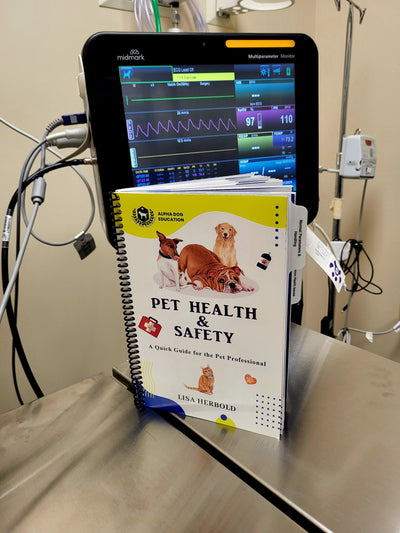Groomers are an important aspect in the health of pets in America. We see and touch every square inch of the pet several times during the grooming process. As caregivers for our regular clients, groomers are uniquely positioned to identify potential health concerns. In fact, groomers have on occasion alerted clients to issues that have saved their pets' lives. The more information we arm ourselves with, the higher the level of care we can offer.
Scanning through social media, I often see posts from groomers who have lost pets in their care, or who have been presented with a health situation that they knew little about or how to adjust their process in order to make it easier for the pet. Let’s face it, grooming is stressful for the pet. Even our regulars find something unpleasant about the process and are stressed. There are also health issues that can be exacerbated by the physicality of grooming itself on top of the extra mental stress it causes. I find myself lamenting and thinking “if they only knew!
Preparation Saves Time, Money and Reduces Anxiety
Arming yourself with this knowledge can save time, money and heartache. During drop-off, always ask the owner if there have been any changes in the health status of the pet. Sometimes you have to ask it a few times in different ways to prompt the answers. Give the pet a quick look-over, if you see a limp, bring it to the owner’s attention. If you see that one or more legs were shaved where an IV catheter was placed, ask the owner why the pet needed an IV.
Depending on the answer and the timing of the groom, you may want to postpone the grooming. For instance, a pet that had surgery should not be bathed for at least 14 days after the surgery. Maybe the pet was very sick and the stress of grooming may be too much at that time. If a red flag presents itself, know that you are well within your rights to ask for a note from the veterinarian that states it is safe to groom that pet. An owner may get upset, but that is better than having the pet go into crisis and the owner now blames you for that. If an owner gives you a bad review for not grooming their dog, it's easier to defend yourself by emphasizing your concern for the pet's health and safety, rather than trying to explain how your lack of knowledge led to harm.
Some pet owners will discount your concern because you are “just a dog groomer”. Show them that you are an EDUCATED dog groomer, that your experience could save their pet’s life. Being able to have an intelligent conversation about their pet’s health goes a long way to enhance the public’s view of “just a pet groomer”. For instance, when asked about any health changes since the last appointment the owner states that the pet now has a heart murmur. Do you know exactly what that means? Do you know if you need to adjust your grooming? Heart mummers are pretty common with both dogs and cats so it is something you should know about.
Even Basic Knowledge Goes a Long Way
As pet professionals, we owe it to our clients to be knowledgeable about common health issues, to recognize the symptoms of a health emergency and to know what actions to take, whether to continue a groom, or send that pet home or to the vet. I saw a need for pet professionals to have this information and with my background as an ER veterinary technician, I decided to use the skills and knowledge I have amassed throughout the years to create a class on that subject, Should He Stay or Should He Go. In this class I explain common health issues our four-legged clients can have, danger signs to look for, and what to do in those circumstances.
Along with the class, I have written The Pet Health & Safety: A Quick Guide for the Pet Professional where you learn how to check the vital signs of a pet and what the normal parameters are. It explains common health issues and the steps you need to take when you come across them. Proper restraint techniques are taught and stress is discussed. The tabbed Quick Guide will give you instant access to the information you need in case of an emergency.
Top 13 Pet Emergencies
According to the American Veterinary Medical Association (AVMA) the top thirteen emergencies are:
- Severe bleeding or bleeding that doesn't stop within five minutes
- Choking, difficulty breathing or nonstop coughing and gagging
- Bleeding from nose, mouth, rectum, coughing up blood, or blood in urine
- Inability to urinate or pass feces (stool), or obvious pain associated with urinating or passing stool
- Injuries to your pet's eye(s)
- You suspect or know your pet has eaten something poisonous (such as antifreeze, xylitol, chocolate, rodent poison, etc.)
- Seizures and/or staggering
- Fractured bones, severe lameness or inability to move leg(s)
- Obvious signs of pain or extreme anxiety
- Heat stress or heatstroke
- Severe vomiting or diarrhea – more than two episodes in a 24-hour period, or either of these combined with obvious illness or any of the other problems listed here
- Refusal to drink for 24 hours or more
- Unconsciousness
Health emergencies happen; how prepared are you?
Reading through them, how many of these emergencies are you confident in your ability to act appropriately? To act as veterinary medicine recommends and not anecdotally? There are a lot of false narratives out there perpetuated by people with little to no veterinary experience. Protect yourself by learning the difference. You cannot be faulted if you follow the recommendations from veterinary medicine. You can, however, be faulted for using anecdotal information (not necessarily true or reliable, because based on personal accounts rather than facts or research) that hurts the pet in the end.
Learning the signs and how to correctly react will make you a better, safer pet professional and also a more knowledgeable pet owner, save yourself some time, money and heartache. First aid involves more than just knowing how to perform CPR. It's also important to learn how to prevent the situations that require emergency medical intervention in the first place. Accidents and health emergencies will happen, will you be prepared?
Be Informed
Groomerverse offers the "Should He Stay or Should He Go' as a comprehensive Pet Health, Safety and Wellness Seminar". We also offer CPR Certifications with PetTech Certifiers. Visit our Seminar Schedule to learn and be informed.
About Lisa
Lisa Herbold, ICMG, MPAe, MGBS, CAH, PGC, FFC, PTI, and author of Pet Health & Safety Guide, likes to meld her knowledge as an educator and groomer with her knowledge as a veterinary technician to better educate groomers on the health needs of pets. Her goal is to improve how groomers are trained to handle health concerns and emergencies, thus making grooming safer for the pet.
Find out More Information with Lisa at:








